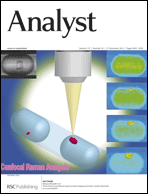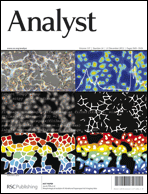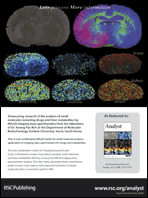With the first issue of Analyst 2013, we also have a good number of HOT papers for you to have a read.
Articles cover a wide range of topics including improved biosensing methodologies, some interesting data on volatile biomarkers of tumour cells and this novel tattoo-based potentiometric sensor (see picture). According to Wang and co-workers, these new tattoos have a potential in measuring strenuous physical activity by monitoring the pH of the skin.
These papers will be free to read until December 12th.
Electrogenerated chemiluminescence of nanomaterials for bioanalysis
Shengyuan Deng and Huangxian Ju
Analyst, 2013, 138, 43-61
DOI: 10.1039/C2AN36122A
Integration of rapid DNA hybridization and capillary zone electrophoresis using bidirectional isotachophoresis
Supreet S. Bahga , Crystal M. Han and Juan G. Santiago
Analyst, 2013, 138, 87-90
DOI: 10.1039/C2AN36249J
Quantification by SIFT-MS of acetaldehyde released by lung cells in a 3D model Abigail
V. Rutter , Thomas W. E. Chippendale , Ying Yang , Patrik Španěl , David Smith and Josep Sulé-Suso
Analyst, 2013,138, 91-95
DOI: 10.1039/C2AN36185J
Tattoo-based potentiometric ion-selective sensors for epidermal pH monitoring
Amay J. Bandodkar , Vinci W. S. Hung , Wenzhao Jia , Gabriela Valdés-Ramírez , Joshua R. Windmiller , Alexandra G. Martinez , Julian Ramírez , Garrett Chan , Kagan Kerman and Joseph Wang
Analyst, 2013, 138, 123-128
DOI: 10.1039/C2AN36422K
Integration of multiple components in polystyrene-based microfluidic devices part I: fabrication and characterization
Alicia S. Johnson , Kari B. Anderson , Stephen T. Halpin , Douglas C. Kirkpatrick , Dana M. Spence and R. Scott Martin
Analyst, 2013, 138, 129-136
DOI: 10.1039/C2AN36168J
Integration of multiple components in polystyrene-based microfluidic devices part II: cellular analysis
Kari B. Anderson , Stephen T. Halpin , Alicia S. Johnson , R. Scott Martin and Dana M. Spence
Analyst, 2013, 138, 137-143
DOI: 10.1039/C2AN36171J
Microfluidic integration of Western blotting is enabled by electrotransfer-assisted sodium dodecyl sulfate dilution
Chenlu Hou and Amy E. Herr
Analyst, 2013, 138, 158-163
DOI: 10.1039/C2AN36033K
Screening reactive metabolites bioactivated by multiple enzyme pathways using a multiplexed microfluidic system
Dhanuka P. Wasalathanthri , Ronaldo C. Faria , Spundana Malla , Amit A. Joshi , John B. Schenkman and James F. Rusling
Analyst, 2013, 138, 171-178
DOI: 10.1039/C2AN35993F
Biofuel cell-based self-powered biogenerators for online continuous monitoring of neurochemicals in rat brain
Hanjun Cheng , Ping Yu , Xulin Lu , Yuqing Lin , Takeo Ohsaka and Lanqun Mao
Analyst, 2013, 138, 179-185
DOI: 10.1039/C2AN36385B
Fast and continuous-flow separation of DNA-complexes and topological DNA variants in microfluidic chip format
Martina Viefhues , Jan Regtmeier and Dario Anselmetti
Analyst, 2013, 138, 186-196
DOI: 10.1039/C2AN36056J
Ultrasensitive detection of mRNA extracted from cancerous cells achieved by DNA rotaxane-based cross-rolling circle amplification
Sai Bi , Yangyang Cui and Li Li
Analyst, 2013,138, 197-203
DOI: 10.1039/C2AN36118C
A biosensor fabricated by incorporation of a redox mediator into a carbon nanotube/nafion composite for tyrosinase immobilization: detection of matairesinol, an endocrine disruptor
Jahangir Ahmad Rather , Sanaz Pilehvar and Karolien De Wael
Analyst, 2013, 138, 204-210
DOI: 10.1039/C2AN35959F


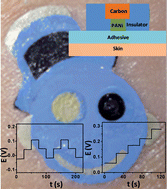










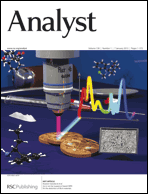

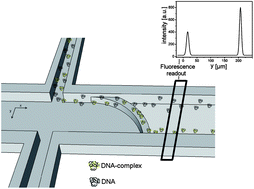
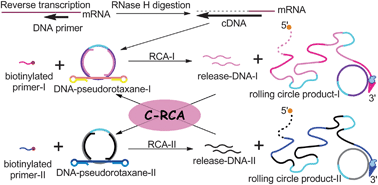
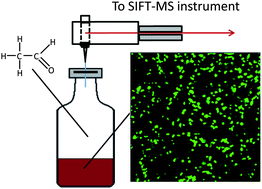


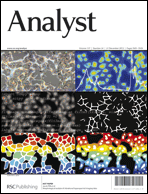 As well as our two
As well as our two 